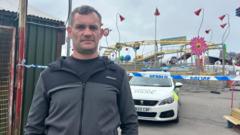Is Your Child Safe on Rollercoasters? Dad Reveals Trauma After Accident

Understanding the Coney Beach Pleasure Park Incident: What Happened and Its Impact
The recent incident at Coney Beach Pleasure Park, where a rollercoaster derailed, has left many in shock and concern. As families flock to amusement parks for leisure and enjoyment, the unfortunate events have raised questions about safety protocols and emergency responses in such environments. With 13 children sustaining minor injuries, including a head injury to one young boy, the incident has transformed a day of fun into a traumatic experience for all involved.
The Incident: A Day of Fun Turns Chaotic
On a seemingly ordinary day, families gathered at Coney Beach Pleasure Park in Porthcawl, Bridgend county, to enjoy its attractions. However, as the clock struck 17:50 BST on Wednesday, everything changed. Witnesses described a "horrific bang" followed by loud screams as the Wacky Worm ride, a third-party attraction not owned by the park, malfunctioned. John Paul Baylis, a father present during the chaos, rushed to assist his son Ethan and other injured children.
Mr. Baylis's account highlights the urgency and fear that enveloped the park. He climbed onto the derailed ride to rescue his son, only to find more children in distress. The scene was one of panic, with blood visible, and the sound of frightened screams echoing in the air. This traumatic experience not only affected the children but also left a lasting impression on the parents, especially Mr. Baylis, who expressed that the fear in the children's eyes would remain with him forever.
Emergency Response and Aftermath
South Wales Police responded promptly to the scene, confirming that 13 children received minor injuries. Emergency services worked tirelessly to ensure the safety of all involved. Coney Beach Pleasure Park took immediate action by clearing the site at the instruction of the police. In a statement, the park apologized for the disruption and announced that they would provide refunds to affected customers.
The Health and Safety Executive (HSE) is also involved, with inspectors attending the site to commence inquiries into the incident. This thorough investigation aims to uncover the cause of the derailment and ensure that similar incidents do not occur in the future. The safety of amusement park rides is paramount, and this event serves as a reminder of the importance of rigorous safety protocols and regular inspections.
Understanding Rollercoaster Safety
Amusement parks are designed to provide thrilling and safe experiences, but incidents like the one at Coney Beach raise critical questions about ride safety. Here are some key factors that contribute to rollercoaster safety:
- Regular Inspections: Amusement park rides undergo frequent inspections to ensure they are in safe working condition. These checks should include mechanical, structural, and electrical components.
- Operator Training: The staff operating the rides must be adequately trained to handle emergencies and ensure that safety protocols are adhered to at all times.
- Ride Design: Rollercoasters should be designed with safety features, including restraint systems and emergency stop mechanisms, to minimize risks.
- Maintenance Protocols: Regular maintenance must be performed to address wear and tear, ensuring that each ride operates smoothly and safely.
- Public Awareness: Patrons should be educated about safety guidelines before riding, including height and health restrictions.
The Psychological Impact on Children
The psychological effects of such traumatic events can be profound, especially for children. Mr. Baylis's son, Ethan, experienced significant distress after the incident, reported to have woken up crying the following day. Here are some strategies to help children cope with trauma:
- Open Communication: Encourage children to express their feelings and fears regarding the incident. Validate their emotions and reassure them that it is normal to feel scared.
- Provide Comfort: Offer comfort and support through physical presence, such as hugs, and emotional support by being available to listen.
- Limit Exposure to Triggers: Try to limit exposure to media coverage or discussions that might trigger anxiety or fear.
- Engage in Positive Activities: Participate in calming and enjoyable activities that can help distract and soothe children, such as drawing, playing games, or spending time outdoors.
- Seek Professional Help: If trauma symptoms persist, consider consulting a mental health professional who specializes in child psychology for guidance and support.
Community Response and Support
In the aftermath of the incident, the local community has come together to support affected families. Many parents have shared their experiences and offered assistance to one another. Community support is vital in helping individuals recover from traumatic events. It fosters a sense of belonging and collective healing. Initiatives such as support groups and community meetings can help families process their experiences and find solace in shared understanding.
Additionally, local mental health organizations may provide resources and counseling services to help those affected by the incident. Together, the community can work towards healing and ensuring the safety and well-being of its members.
Future Considerations for Amusement Parks
As investigations continue, it is essential for amusement parks to re-evaluate their safety measures and operational protocols. Here are some recommendations for future considerations:
- Enhanced Safety Protocols: Implement more stringent safety protocols and regular audits of rides by independent safety experts.
- Transparent Communication: Maintain open lines of communication with patrons regarding ride safety and any incidents that occur.
- Community Engagement: Involve the community in discussions about safety and invite feedback from patrons on their experiences.
- Emergency Preparedness: Develop and practice emergency response plans that ensure all staff are trained and ready to act in case of incidents.
- Technological Innovations: Invest in technology that can enhance ride safety, such as real-time monitoring systems that alert operators to potential issues.
Conclusion: Reflecting on Safety and Well-being
The incident at Coney Beach Pleasure Park serves as a stark reminder of the importance of safety in amusement parks. While such experiences can be harrowing, they also present opportunities for improvement. It is crucial for amusement parks, parents, and communities to work together to ensure the safety and well-being of all individuals. As families continue to seek joy in amusement parks, their safety should always come first.
As we reflect on this incident, it’s essential to consider how we can contribute to a safer environment for future generations. Are there specific safety measures you believe should be prioritized in amusement parks? #RollercoasterSafety #CommunitySupport #ChildTrauma
FAQs
What happened at Coney Beach Pleasure Park?
A rollercoaster, the Wacky Worm ride, derailed, causing injuries to 13 children, including one child with a head injury. The incident prompted a swift response from emergency services.
How many children were injured in the incident?
Thirteen children received minor injuries during the rollercoaster derailment at Coney Beach Pleasure Park.
What can parents do to help children cope with trauma after such incidents?
Parents can encourage open communication, provide comfort, engage in positive activities, limit exposure to triggers, and seek professional help if necessary.
What steps should amusement parks take to improve safety?
Amusement parks should enhance safety protocols, maintain transparent communication, engage with the community, prepare for emergencies, and invest in technological innovations to monitor ride safety.
```Published: 2025-08-14 19:25:12 | Category: wales



